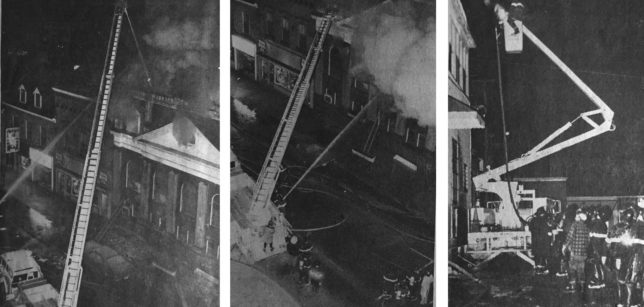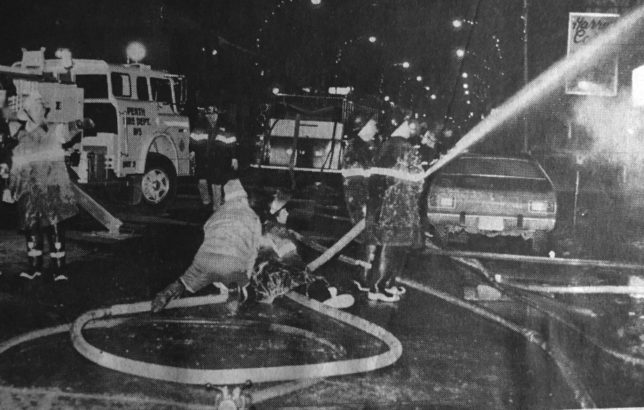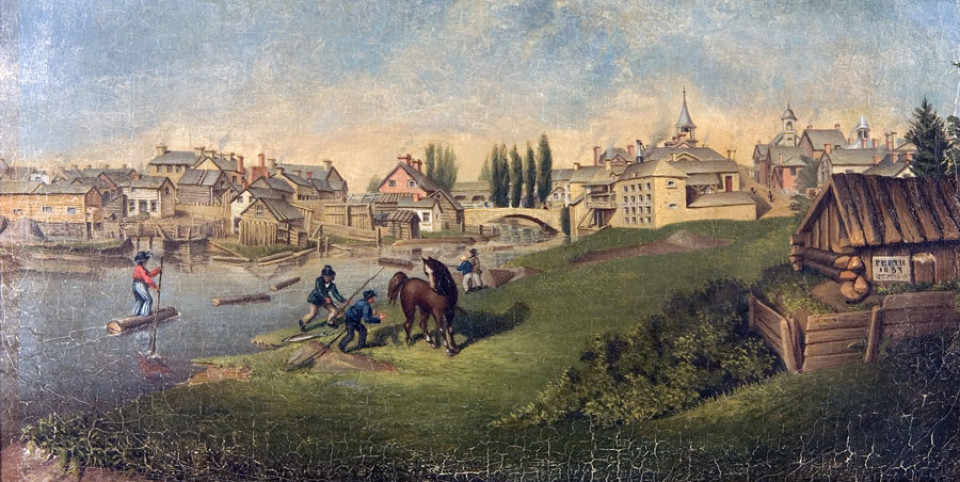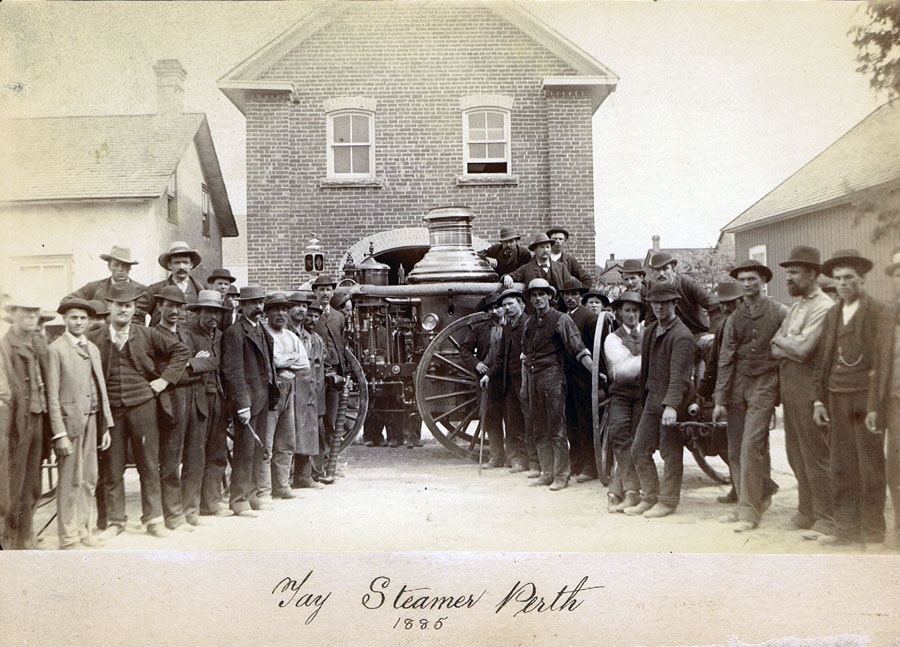
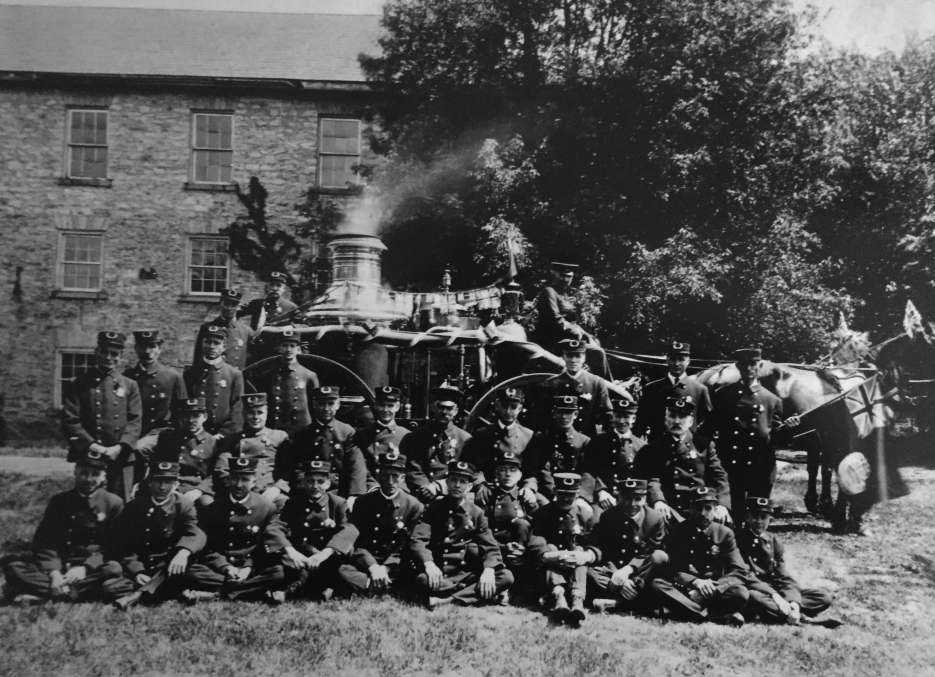
From the Courier files: Perth’s firefighting history dates back to departments established in the mid 1800s. Two fire companies were formed, the Union, of which Sam Bothwell was captain and the Fountain headed by John Murray. Each company consisted of a bout 50 or 60 men. The east ward was serviced by the Fountain and the west ward supported the Union. Excerpts from the 1859 Constitution and Bylaws of the Union Fire Engine Co. of Perth show a little of the nature of the old fire brigades. Members of the Union Company wore red shirts and black trousers, while the Fountain company members attire consisted of white trousers and blue jackets.
The company was divided into four sections – hose, suction, after-brake and forward-brake. it sensated of a captain, 1st lieutenant, 2nd lieutenant, secretary, assistant secretary, treasurer, engineer, four foremen, ranchman and assistant ranchman. In addition, not more than 50private members could make up the company. men ages 18 to 48 could join the brigade. Among their many duties, the ranchman and assistant ranchman were instructed to be “careful not to give offence to any member of the fire department by carelessly or wilfully wetting them” . A number of fines were set for a variety of offences, such as missed meetings without good reason, leaving meetings early, ringing the engine house bell without cause and getting on the engine or hose-reel without consent. These fines cost a member a whopping twelve and a half cents. Members were not allowed to smoke in the meeting room during the time of business. Drunk and disorderly behaviour while on duty or while wearing the company uniform meant expulsion. Religion and politics were forbidden topics of conversation at meetings.
Equipment
In February 1883, the new Ronald steam fire engine, costing $3,700.00 arrived in town and underwent severe testing. An historical account notes the engine was taken to the river at the Locks Bridge (Gore Street) and two streams of water were thrown over the dome of the town hall. In 1898 the Union and the Fountain companies were merged into one – the Perth Fire Brigade with D. R. Noonan as fire chief. In 1906 the Tay Steamer was tested. It threw a vertical stream of water 120 feet, which was higher than any building in Perth at that time. Mr. Gamble joined the company in 1891 and served 33 years as fire chief, from 1917. A poster from 1917 invites one and all to the Second Annual Firemen’s Night at the Perth rink. The event featured sports activities, skating until 10:30pm, a firemen’s race on ice wearing boots, a boys’ race and a hockey match. Admission was 25 cents and children under 15 could get in for 15 cents.
Changing
The fire department was housed in the old firehall on Herriott Street until 1971. The Fire Hall on Herriott Street was built in 1855 and was erected to provide protection for the pumper, house Perth’s early fire fighting equipment and the tower was used for the drying of the fire hoses. Construction was completed in October of 1883 with a second for addition to the engine house. The brick building had adjoining living quarters and a 65 foot tower at the rear of the building was used for hanging hoses. Following a fire one man would climb to the top of the tower on a ladder, (interior stairs were added some time later) a rope and hook would be dropped down, where sections of hose, once connected would be pulled up the tower to hang down to drip. To facilitate the drying process a stove, blazing with a good fire, was located directly below the hanging hoses. A worn depression and a drain in the floor of the main room of the engine house showed a well worn path where surplus water was drained from the hoses and allowed to escape to an underground well outside. To alert the firefighters of a fire there were at least three alarm bells in the town. The bells were located one at the town hall, one near the present day United Church and one at the corner of Gore and Brock streets. These alarm bels indicated the possible direction of the fire. When the signal came, men, all volunteers, and teams of horses followed the call of the warning alarm.
In 1940 the town purchased a 1939 American La France for just over $9,000. It could pump 600 gallons of water per minute, carried a 40 foot extension ladder and had a 100 gallon water tank. It also included fire extinguishers, axes, pike poles, hose, nozzles, gas masks, helmets, coats, mitts and other accessories. The town donated a St. John Ambulance first aid kit. The La France was first used in 1940. Its last active service was at the library fire in 1980. The town was serviced by an electric siren, which was installed on the roof of the town hal in 1943, and was controlled by a switch at the front entrance until a paging system was instituted in 1975. The sound could be heard from five to seven miles depending on weather conditions. The new firehall behind the town hall was completed in the summer of 1971. 1 107 year old stone building was demolished on that site to make room for the new hall. The old building had originally housed the famed Perth Market but was converted to a band room and caretaker living quarters decades before when the farmers’ market petered out. The need for the new firehall became apparent when the town ordered a $30,000 pumper which would not fit into the old hall.
Over the years the department fought a number of serious fires, including the Hotel Perth fire in April 1959 which gutted the historic structure, killed two men and injured several firefighters. Carson Farm Supply on Drummond Street was destroyed by fire in August 1961. In June 1959, the devastating Lanark fire destroyed blocks of the village’s businesses and homes causing $2 million in damage. The Erwin block on Gore Street was gutted in November 1972 destroying apartments and four businesses including Thomas Hardware, a coin laundry, Eatons order office and Avco Finance offices. In 1980 the Perth department fought three serious fires, including the library, the Matthews Building and the IGA.
Fire, December 1891

This could have been a devastating fire for the centre of town because of high winds but luckily it was not. The fire was first believed to be started by tramps but it was later discovered that was be set by theives “as there were whistling calls and responses as if some scheme in collusion were under way; then the hose was cut, with the evident object of preventing the fire being checked, so that plunder thieves could do their work. Other little things seen or considered tend to the same inference. The Town Council agree with the current opinion and ordered a reward to be offered for the arrest and conviction of the perpetrators. Two or three parties are under suspicion”: The Perth Courier, December 18, 1891. Following is the account of the fire as written.
PERTH COURIER, FRIDAY DECEMBER 11 1891
DESTRUCTIVE FIRE IN PERTH. Great loss of Property. Nearly $40,000 gone in smoke. December 9, 1891
About half past one o’clock on Wednesday morning the people of the town were aroused from their slumbers by the tolling of the alarm bell in the Catholic Church, and on rising a bright glare of light was observed in the centre of the town. It was soon found that the Douglas block on Gore Street was the scene of the conflagration. The fire was discovered by Mr. Andrew Robinson, who was driving the hicks’ House bus from the train and he gave the alarm. The Doulas property was occupied by Mr. Henry Taylor, hardware merchant, whose shop was in the south end and whose storehouses extended in a long range to the rear of the lot; the north end was occupied by Mr. M.R. Dodds, as a flour store, with a storehouse behind. North of this was a one story frame building owned and occupied by J. M. Poole as the Star printing office. South of the Douglas block was Mr. G. F. Barrie’s butcher-shop, and Mrs. Mairs’ boarding house in a block owned by Mr. Barrie. Above Mesars. Taylor and Dodds were the dentistry office of Mr. J. H. McCulloch and the photograph gallery of Mr. w. H. McIntyre, neither of whom saved anything. The fire stared in one of Mr. Taylor’s storehouses about the middle of the range, and and from the fact that no fire was ever going near this place and only lanterns used for lighting, it is supposed the fire must have been the work of tramps, a number of whom are always on their pilgrimage through the town. In no other way could the fire be accounted for. A fierce wind was blowing at the time from the south and drove the flames on quickly towards Mr. Taylor’s and against the Star office which being of inflammable material was almost in a breath involved by a sheet of fire. The forms and a few cases of type were saved but that was all. The presses, machinery, stationery, furniture, etc, was swept away in a very short time. Mr. Dodds’ store was also very soon a devouring mass of flames, and not a thing was saved. Mr. Taylor’s store and stock was the most valuable property in the whole fire district. Both front and back stores were filled with iron goods of all kinds to the value of perhaps sixteen thousand dollars, and of this a few hundred dollars worth only, were rescued. More perhaps might have been got out but the fear of powder and cartridges exploding kept the people out after the fire entered the store. And then the gale drove the flames all through so quickly that smoke and fire soon filled the whole place. Mean time the steamer engine was fired up in its place in the engine house, the hose stretched to the place, but delay arose in getting a stream of water to bear on the flames, want of practice no doubt kept down the speed necessary to meet an energy at once, but chief and men exerted themselves with coolness and vigor, and streams of water both in front and rear after a time played constantly in the flames, assisted by one from the hand engine. The rest of the wooden outbuildings in the rear increased the danger of the fire spreading in that direction, and to meet this contingency, as well the danger at other points, the Mayor of Smith’s Falls was telegraphed to send up their fire steamer and a body of firemen to help our own firemen. This was generously responded to and in an hour or less the Smiths Falls steamer and men, with the Mayor, Reeve and other citizens were at the station and soon after taking position at Dennison’s Bridge, and streams playing on the flames also.
The fire had gained ground until it caught on Mr. Andrew Barrie’s stone building and after gutting this block completely and destroying the out-buildings was checked and finally subdued. Mrs. Laurie’s fine brick block, north of the burned district, was at one time in great danger but the good brick walls mostly free from windows and the efforts of the firemen saved it. Buildings were in danger far and near northward, owing to the huge flakes of burning wood, but flying the snow on the roofs helped to smother any incipient flames, and no other fire broke out in spite of the gale. All the plate glass windows in the Matheson buildings occupied by Miss Wallace, Mrs. Jordan and Mr. Wm. Northgraves, were cracked by the heat and of course destroyed.
The buildings destroyed and the lot left vacant until the Balderson Theatre was built in this location.
The loss will aggregate about $40,000 and is distributed something as follows:
Douglas Estate Loss 8,000. Insurance 6,000.
Henry Taylor Loss 16,000 Insurance 10,000
M. R. Dodds Loss 3,000 Insurance 700
W. H. McIntyre Loss 2,000 Insurance 600
J. H. McCulloch Loss 1,000 Insurance 500
J. M. Poole Loss 5,500 Insurance 3,000
Andrew Barrie 3,000 insurance 3,000
Malloch Estate Loss 150
Mrs Mair and boarders Loss 500
Miss Wallace Loss 400 Insurance 400
Mrs. Jordan Loss 100
Matheson Estate Loss 150
St. Andrews Parish Fire, 1923

THE PERTH COURIER, MARCH 14TH, 1923.
St. Andrew’s Church and Sunday School Fall a Prey to Fire. Completely destroyed early Sunday morning.
“By far the worst calamity which has befallen Perth in many years was the disastrous fire early Sunday morning which completely destroyed the historical St. Andrew’s Presbyterian Church and Sunday School at the familiar site at the corner of Craig and Drummond Streets. What was previous to Sunday a beautiful edifice the pride of the pastor and congregation is now a mass of charred debris with only the four walls of the church and the Sunday School walls left standing. The fire was discovered between two and three o’clock in the morning when smoke was seen issuing from the basement of the Sunday School. Night Patrol Kane was notified and went to the church where he found all the doors securely locked and the windows closed. Listening with this ear to the door at the Sunday School he heard the cracking of fire and then immediately rushed to the Town Hall to ring in the alarm. In the meantime Mr. William Ferrier, the caretaker was notified and took no time in getting to the fire and opening the doors for the fire fighters. The firemen responded in remarkable time to the alarm hurrying to the hydrant on Craig Street near Beckwith. The hydrant then was found to be frozen and it was abandoned. The firemen then proceeding to the hydrant in front of the Court House and to it two lengths of hose were attached and then the fight with the flames began. The Sunday School room was filled with smoke which was so dense that the firemen found it impossible to remain in it at any greater length than a few seconds at a time. As a matter of fact several of the firemen were almost overcome with suffocation but they worked away, chopping the floor, partitions and stairways and all the while continuing the streams of water until it was thought the fire in the Sunday School was under control and that the Church would be saved, many of the spectators returning to their homes fully convinced the fire was all over, However such was not the case as the flames found their way to the church and it was such apparent to the edifice was doomed to total destruction. About 4:30 o’clock the flames reached the roof and an hour or so later the roof fell in, the whole presenting a spectacular seething furnace of fire. The firemen continued pouring the streams into the burning debris and at 7:30 o’clock the fire was considered under control. The firemen claim it was the most difficult fire they have ever had to fight in Perth and their herculean efforts to save the church and other adjacent properties have met with highly favorable compliments in the town. During the progress of the fire the neighbours kindly furnished the firemen with hot coffee, tea, cake etc. Of the church equipment all that was the communion service and the War Memorial Tablet.
Thus has passed the desolation and smoking ruin what was fro ninety one years the landmark of Presbyterianism in the Perth settlement. Built in 1832 renovated and enlarged in 1898 it had the reputation since the latter date of being in its interior the prettiest Protestant church in town and comfortable and cozy as it was handsome. The walls of the old church were not placed where they were without the toil, self-denial and liberality of the early Presbyterians of Perth. Money was scarce in those days and the farmers on the Scotch Line and adherent concessions gave their labour gratis and made sacrifices in many ways to provide themselves with a permanent place of worship and it cannot be denied that they met the needs successfully. Now, although the time-honoured church building, like the pioneers who built it, has passed off the scene, the memories of building and builders should not be allowed to pass into oblivion no matter what the future of the congregation of today may be”
FIRE ON FOSTER STREET – SIMPSON’S FURNITURE STORE 1950s
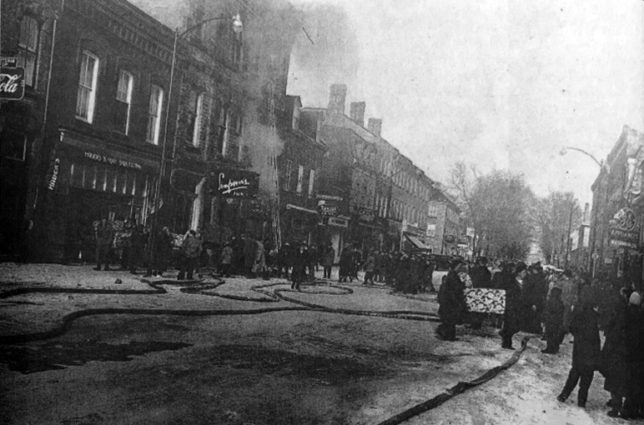
THE HOTEL PERTH FIRE, APRIL 28th, 1959.
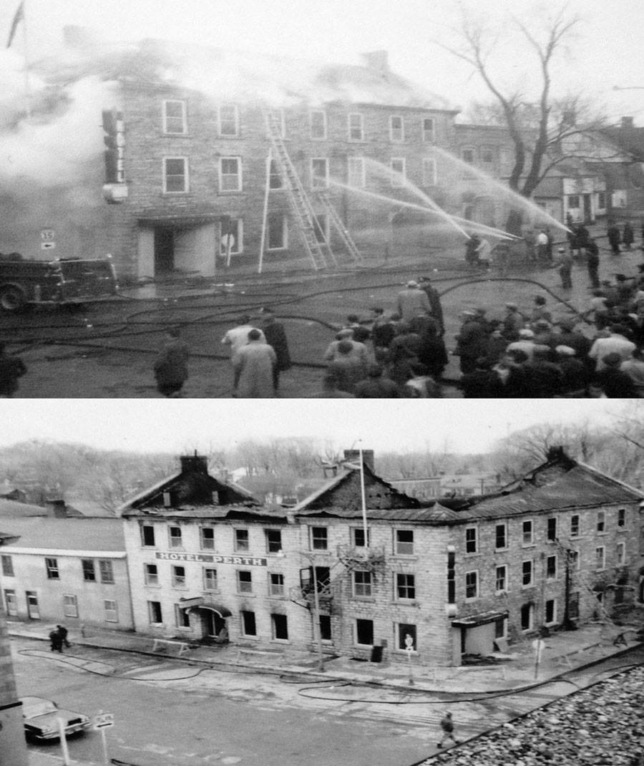
The picture on the top shows firemen battling the blaze from the Foster Street side of the building. The picture on the bottom, taken from the top of James Brothers hardware, shows the ruined building on the following day. Loss was estimated at $250,00.000 and two men, Percy Spalding of Perth and W.L. Palmer, a lumber salesman from Toronto, were asphyxiated in the blaze. Harry Sinclair and Mansel Small raised a ladder to the window in Mr. Spaldings room which was on the third storey facing Foster street. Smashing the glass in the window the two men entered the room and found Mr. Spalding sitting in a chair in an unconscious condition. They carried him down the ladder and he was taken to the Chinese Laundry next door. Efforts were made to revive him but he passed away soon after. Mr. Palmer’s body, was found latter in the corridor by Howard Wallace a Perth Fireman. Fire brigades from Smiths Falls, Carleton Place and Lanark sent their pumpers and crews to assist the local brigade to fight the blaze which had enveloped the whole building and could have spread to adjacent structures. About 15 streams were splayed on the fire. Two pumpers were located near the Little River and were in operation for nearly five hours. The Salvation Army served coffee to the firemen. Allen’s Bakery served sandwiches while Tayside Bakery supplied doughnuts and pie. The local branch of the Canadian Legion threw their doors open to the firemen where they were supplied with hot coffee. Crowds from neighboring towns and hamlets poured into town with the result that Gore and Foster streets in the vicinity were crowded. The Bell Telephone exchange, which is situated in ta separate building on Gore Street, at the extreme north of the hotel premises, escaped with only smoke damage as the fire was stopped before it reached the exchange. Earlier in the evening it was a question whether the fire would reach the telephone exchange, but the operators stuck to their posts throughout the trying ordeal and business was carried on as usual. This was the most disastrous fire in the history of the town.
HOW THE FIRE STARTED
From reliable sources it is reported that while Dorothy James and Phyllis Barr were on duty in the grill around supper time, prior to the outbreak of fire, they found that the deep-fat fryer was out-of-order. Mr. Delaney, manager of the hotel, was informed and gave instructions to Mr. Smail, an electrician, to check on it and put it in order. Mr. Smail went downstairs to fix the wiring connecting the deep-fat fryer and the fryer was put back into operation but the fat got overheated and burst into flame to a height of 3 to 4 inches. In order to cool the fat raw potatoes were placed in the fryer but this did not have the desired effect. Mr. Farrell, another employee, suggested that baking soda be thrown over the fryer to quell the blaze. With the baking soda having no effect on the flames, Mr. Delaney used the fire extinguishers and called the Fire Brigade. During this time the fire got out of control.
The Erwin Block Fire, 1972


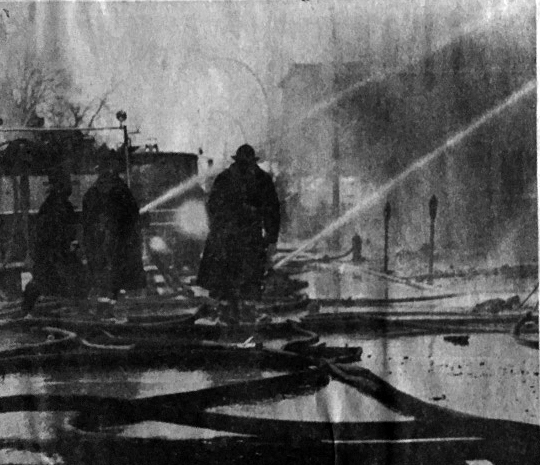
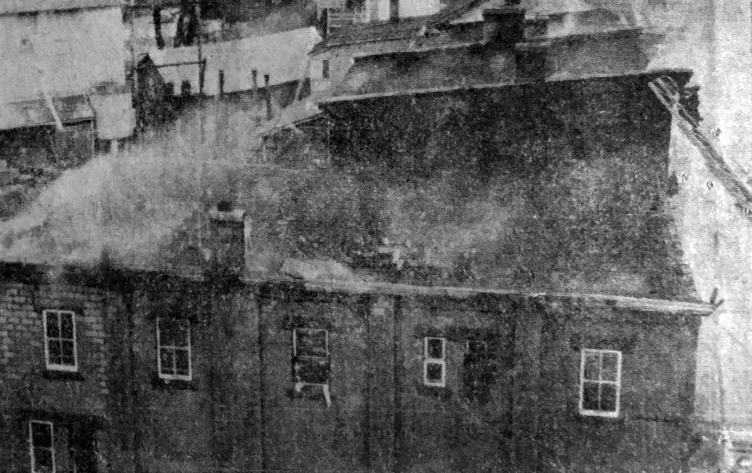

CENTURY OLD BUILDING BLOCK GUTTED BY FIRE – NOVEMBER 1972 – Current location of TD Bank.
It was a miracle that no one was killed or seriously injured in the $250,00 fire which swept through the stone building known as the Erwin Block, on Gore Street E, near the Town Hall.
The two-storey apartment building along with a penthouse was occupied by elderly people who came to near panic when the alarm sounded and they found the stairs and halls were filled with smoke.
Gerald Dean noticed the fire and notified Constable Dulmage. The fire seemed to be contained to the Tin Shop owned by Roy Kilpatrick.
Constable Dulmage and Robert Scobbie helped to arouse the residents on the second floor. They were led down the stairs and the smoke was so thick they had to feel their way to safety. The residents were then directed to the Town Hall where their relatives were notified and came to give them shelter in their homes. To make sure no one was left in the buildings, Scobbie raced back into the smoke-filled apartments for a final check. As conditions grew worse, he found himself stranded and had to make his way out of the building by smashing a window on the second floor. The brave young man was rescued by Constable Dulmage who heard the crash of glass and placed a ladder up to the window.
The Salvation Army officers were at the scene very quickly to serve hot drinks and sandwiches to the firemen. Nelson King a local merchant also served hot coffee during the early hours of the morning.
Two firemen, Deputy-Chief David Bell and Ron Jenkins were taken to hospital for treatment after being cut by flying glass when an explosion too place at approx. 5:45 am in the Avco offices.
The fire is believed to have been caused by an electric short. Considerable smoke and water damage was done to the adjoining building which houses DiCola Fuels, New Style Shoppe and Haggis Candy Store.
$1,000,000 BLAZE DEVASTATES LIBRARY 1981
